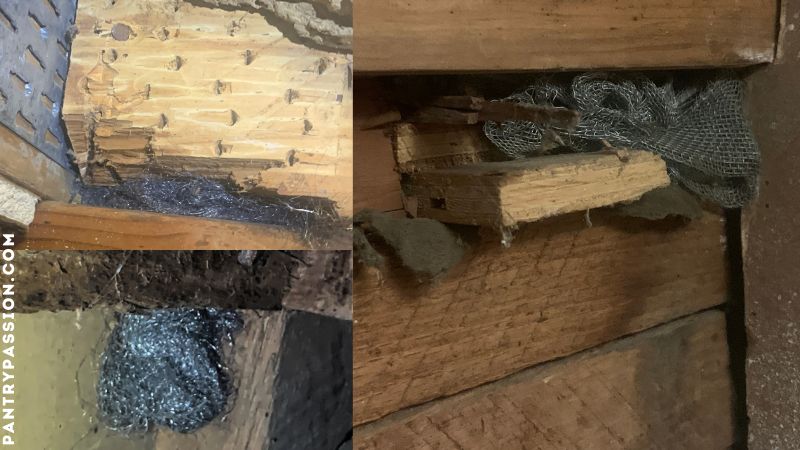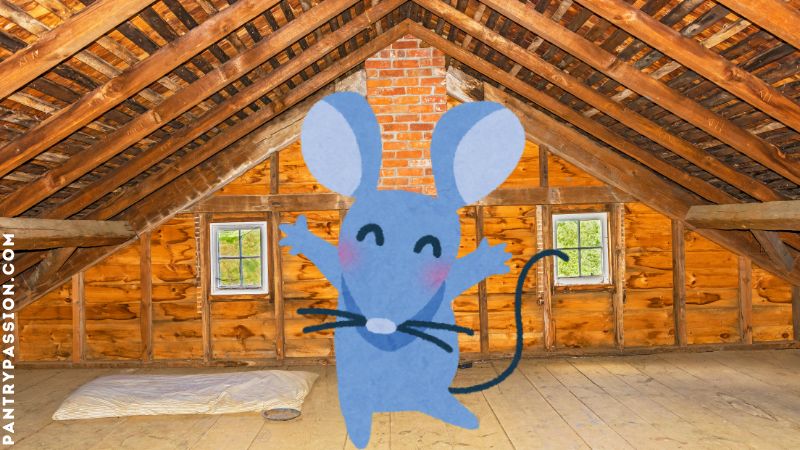The Best Fluffy Pancakes recipe you will fall in love with. Full of tips and tricks to help you make the best pancakes.

If you spot signs of mice in your attic, it’s time to act fast—mice reproduce quickly, and a small problem can become a full-blown infestation in weeks.
As for rats – it’s a whole different ball game. Where mice get stopped, rats keep going, even chewing their own entry points into the attic. They’re clever, too. As a farmwife with a history of living in old farmhouses, here is some of my advice on getting rid of mice in the attic.
The rats often require beyond sneaky strategies.
DON’T MISS Pantry Passion’s Complete Article List for Mouse & Rat Prevention!
Table of Contents
- Step 1: Clean & Declutter the Attic
- Step 2: Kill Mice in the Attic
- To Clean or Not to Clean After Mice in the Attic
- Enzyme Spray: Does it Remove Dead Rat Smell & Urine?
Step 1: Clean & Declutter the Attic
Step one: clean and declutter to cut down on mouse activity. Mice love hiding in piles of old clothes, cardboard boxes, and forgotten holiday decor. Swap cardboard boxes for sealed plastic bins, and avoid storing food or pet supplies in the attic. Prevention is the secret ingredient to keeping mice out for good.
Just getting clutter under control can help get rid of mice in the attic.

Now is a good time to get your flashlight and examine the attic. It might be really difficult if it’s full of loose attic insulation or fiberglass insulation batting. If you only have a crawl space, it might be really difficult to get up there. You can always consider a camera on a stick that can give you more information.
Even if you enlist the help of a professional, they should report back to you with photos and video that allow you to see rodent evidence with your own eyes.
The next step is to move on to traps and poison, or hire a pest exterminator to do it for you.
How to Find Mice Entry Points in the Attic
Mice can squeeze through holes as small as a dime. To find their secret entrances:
- Walk around your home’s exterior with a flashlight
- Check rooflines, soffits, vents, and chimneys for gaps
- Look for rub marks, droppings, or shredded insulation near suspected entry points
- Use flour or talcum powder near gaps to track footprints
- Temporarily plug holes with steel wool—if it’s chewed, you’ve found an active route

Seal confirmed entry points with caulk, metal mesh, or weatherstripping. And don’t forget to trim tree branches that touch your roof—they’re rodent highways.
Believe it or not, one pest control expert had a different take on sealing attic holes, “We never close entry points (unless they are obvious and easy to close) because it’s almost a guarantee that any kind of rodent will find another way in. You’ll just be playing whack-a-mole closing entry points.”
You can drive yourself crazy trying to block the thinnest of holes. However, you owe it to yourself to seal the most obvious offending openings.
Step 2: Kill Mice in the Attic
If you really want to get rid of mice in the attic, you need to kill them. If you’re going the lethal route, snap traps are your best bet. They’re quick, effective, and don’t leave mice to die slowly in your walls. Place traps:
- Along walls and beams where mice travel
- Near droppings or gnawed areas
- In pairs for higher catch rates
Glue traps lead to all sorts of problems—they’re inhumane and often ineffective. Want to supercharge your catch rate with snap traps? Check out my tips on mouse trap strategy, and then complete it by checking out good bait for mouse traps.
Check traps daily and reset or replace as needed. Place mouse traps in enclosed setups (like shoeboxes) to mimic safe tunnels.
The Twin Home Experts Rat/Camera/Bait Station is pretty impressive (these guys are operating on a whole different level!):
- Set snap traps baited with peanut butter along walls and beams.
- Use live traps if you prefer a humane approach (just release far from home!).
- Consider electric shock traps for quick, clean kills.
- Some people advise to avoid poison because it can lead to dead mice in hard-to-reach places and pose risks to pets.
Snap traps on top of the insulation is sort of worthless. Snap traps are more effective on a solid surface. Some people even slide the snap traps under the fiberglass batting. You might catch some mice this way, but the weight of the batting can lead to failure or false triggers.
Special Attic Poison Tips for Rats
Rats are scary clever. Just watch a few episodes of Twin Home Experts, a popular Youtube channel. One of the twins even talks about rats studying the behavior of people, such as coming and going. They know when you leave for work and then can enjoy themselves, uninterrupted.
Even worse, rats can climb up sewer pipes, getting into your attic. According to the Twins, roof ceiling tiles are the worst, rats can get into them super easy.
They know when poison makes them sick, and to stop eating it. They see their dead buddies, and make the connection that the food source killed them. Like I said – scary.

Rats can be picky eaters. One pest control expert always uses two types of baits with the same active ingredient (more taste options for the rat). This approach is often used in attics where it may take extra effort to place the poison – you want to do it right the first time.
Hearing numerous times that previous exterminators failed is disheartening. Twin Home Experts prevail, because they think like the rat does. By using rat psychology and behavior, they often win. If you’re up against a rat problem, watch their videos and consider professional exterminators. They have access to more toxic poison than consumers have.
The most important advice: poisoning mice or rats is not a one-time event. Continue to heavily bait the attic (using at least two brands of bait) and keep bait stations full and place around the house/property in rodent-frequented areas to prevent future infestations!
What if There’s No Attic Access?
There’s nothing worse than hearing scratching, and knowing you have no good way to get to where the mice are hiding.
In extreme situations, you may have to cut the ceiling out and place bait if you have no access to the ceiling. Or consider cutting an access hole in the floor or walls to insert traps/bait. Any traps used should be tied with string to a fixed point outside the hole so you can retrieve it if needed. The hole can be finished with a removable cover when done (sorry folks, cutting is really the only way to place poison inside of wall cavities).
Is Tossing Bait Around a Bad Idea?
Honestly, I never thought of poison bait packs as harmful to your health or the conditions the hot/cold weather affecting the bait pack in the attic. Here’s the scoop:
Reddit member RaulTheAwful: “Attic insulation doesn’t need to be changed. It’s a vented attic. Air comes in through the soffits, and out through the roof vents. There is no significant air exchange between attic and house. Only time I would recommend having it replaced is if it was low, or if you were selling the house (in which case you would replace to not scare off buyers).”
What the Farmwife says: Toss in those poison packs! Hit it up in the fall when the cold weather rolls in. Toss some more up in the attic in February, this should stop them cold.
-Farmwife Renee, PantryPassion.com
If you’re like me, I just throw poison pellets into the corners. Someone asked if pellets in a hot attic would give off fumes? Extreme attic heat (often exceeding 120°F in summer) can accelerate the breakdown of certain chemicals. Most modern rodenticides are designed to minimize airborne exposure.
If you’re worried about poison being buried in the attic insulation and you can’t retrieve it – I would say ignorance is bliss. It would be impossible to get all of the rat and mouse poop out, along with flecks of poison. If I am on a constant cycle of re-baiting my attic, and no humans live up there, I’m good with it.
To be clear, I am not advocating for leaving a ton of rat poop up in your attic. There’s just a common sense point when to leave it, and when it becomes a health hazzard.
Bait Block Advice in Attic
Some experts advise not to throw poison bait blocks all over the attic, for several reasons. How can you know where it is being eaten and NOT eaten? It can attract bugs, like pantry moths. Keep bait where you can check it. If I use bait blocks, I place them on a Styrofoam plate, and scribble the date on it with a marker to track activity.
Reddit member RusticSurgery: “I use the block type bait with a hole in the center. I run kite string through the hole, give my best toss, then tie the other end somewhere i can access so I can reel it in later to see what places it is being eaten and NOT eaten.”
Not interested in poison packs or bait blocks? Look into bucket traps – you will know where the dead mice are. Although not as common of a attic strategy, it works.
Where to Place Mouse Traps in Attic
| 📍 Location | 💡 Why It Works |
|---|---|
| Along walls and beams | Mice hug walls and structural edges for safety. Place traps perpendicular to the wall with bait facing the wall. |
| Near insulation | Mice often burrow into or nest near insulation for warmth and shelter. |
| Close to entry points | Look for gaps around vents, pipes, or rooflines—these are common mouse highways. |
| Dark corners and crawl spaces | Mice prefer quiet, undisturbed areas. These spots are ideal for trap placement. |
| Near signs of activity | Droppings, gnawed materials, or urine stains are clues to their favorite paths. |
To Clean or Not to Clean After Mice in the Attic
So the traps are set, the scratching has stopped, and the mice have finally moved out. You’ve done your due diligence and blocked the entry points. The question is, do you need to clean after the infestation and/or remove it?
I’m being very practical here. There are all kinds of attics and crawl spaces. Some are very difficult if not impossible to get into (thus the word “crawl”). On top of that, blown in insulation and the fiberglass insulation bats are not something easy to clean.
Let’s get real – how big is the stink? Mice=little bodies=short stink time. Trust me, you can survive it.
When mice die in the walls they generally don’t have enough body mass to make a huge stink. Rats will stink up a place for weeks, if not months. It’s simple math, they’re bodies are bigger than mice, resulting in an undeniable, stinky event.
Health Concerns
I don’t lightly dismiss the concern of hantavirus. Attention was drawn to this disease that mice carry when famous actor Gene Hackman’s wife died from it.
Regardless of where you live, rodent droppings need to be handled with care. Bacteria and other diseases can become airborne when disturbed. That means sweeping or vacuuming without precautions can actually make things worse. Droppings are typically small, dark, and rice-shaped, often found near insulation, beams, or storage boxes.
Air quality. Some may argue that attic air is separated from the lower floors of the house, so contamination shouldn’t be a concern. However, Reddit member ltdan993 says that “If they [rodents] chew into you HVAC (which does happen) it starts mixing the contaminated air in the attic with the air that is blown into your home.”
Step-by-Step Attic Cleanup
- Gear Up
Wear gloves, a mask (preferably N95), long sleeves, and safety goggles. Ventilate the attic if possible by opening windows or using fans. - Disinfect First
Spray droppings, urine stains, and nesting areas with a disinfectant or bleach solution (1 part bleach to 9 parts water). Let it soak for at least 5 minutes. - Careful Removal
Use paper towels to pick up droppings and nesting materials. Double-bag everything and dispose of it in a sealed trash can. - Deep Clean Surfaces
Mop or sponge hard surfaces with disinfectant. For insulation, inspect for contamination—if it’s heavily soiled, it may need to be replaced. - Wash Up
Clean gloved hands before removing gloves, then wash your hands thoroughly with soap and warm water.
Enzyme Spray: Does it Remove Dead Rat Smell & Urine?
Rat urine is some potent stuff. Using enzyme sprays on attic insulation as a rodent deterrent is a relatively niche strategy, but it’s gaining attention among homeowners looking for non-toxic pest control. Twin Home Experts, a popular Youtube channel, even markets their own Twinzyme Odor & Urine Removal.
The Twin Home Experts team generously sprays the enzyme treatment on when closing up spaces, as the last touch on a project. I get the feel, though, it’s more of a feel-good strategy for the home owner, than a deterrent. Homeowners are left disgusted with odors and smells, especially after rats. It may be psychological, but customers are plenty happy to have a pleasant fragrance greet them.

Some pest control experts claim that they can distinguish between urine from rats vs mice, but it’s not always straightforward. This chart lays out the differences:
Key Differences Between Rat & Mouse Urine
| Feature | Mouse Urine | Rat Urine |
|---|---|---|
| Volume | Small, frequent droplets | Larger, more concentrated puddles |
| Odor | Musky, slightly sweet | Stronger, more pungent ammonia smell |
| Location | Scattered trails near nesting zones | Often found in latrine-like clusters |
| Droppings Nearby | Small (1/8 inch), pointed ends | Larger (1/2 inch), blunt ends |
| UV Detection | Fluoresces under blacklight | Also fluoresces, but in larger patches |
Benefits of Using Enzyme Spray on Attic Insulation
- Odor Neutralization: Enzyme sprays break down organic matter like urine and feces, eliminating the scent trails that attract other mice to the same nesting area. It also helps with the more challenging odors of dead rat smell.
- Non-Toxic & Safe: Most enzyme sprays are pet- and child-safe, making them a good alternative to chemical repellents or poisons.
- Discourages Reinfestation: By removing pheromone markers, enzyme sprays can reduce the likelihood of mice returning to previously infested areas.
- Can Be Combined with Other Methods: Works well alongside traps, sealing entry points, and insulation upgrades.
Requires Reapplication: Enzymes degrade over time and may need to be reapplied, especially in humid or dusty attic environments. Without sealing entry points or removing nesting material, enzyme sprays won’t stop a determined rodent.
Enzyme Products to Spray on Top of Attic Insulation
If you’re looking for an enzyme product to break down the lingering scent and bacteria from rat feces—try one of these products recommended by Reddit users:
- Attic Fresh
- Anti Icky Poo unscented enzyme liquid. Put it in a pump sprayer from home Depot and apply and let it soak in
- Odoban – I’m seeing 5 star approval ratings on Amazon for this enzyme cleaner product – unheard of. Click on it and see 92% approval, again, unheard of in Amazon land.
These are non-toxic enzyme-based spray specifically designed to:
- Break down organic waste like rat feces and urine
- Neutralize odors that attract future rodents
- Disinfect surfaces including insulation, wood, and drywall
- Leave behind a fresh scent, often citrus behind
GOOD NEWS! Persons with allergies report that this type of enzyme product does not irritate them.
DIY Sanitize Your Attic
If you want to spread the enzyme application yourself, it’s totally doable. Here are some tips from people who have done it themselves:
Chance-Day323 “To sanitize I’d get a sprayer, good ventilation, good PPE including goggles and face mask, and use 10% bleach solution to spray it all. It’ll dry if you have good airflow, and if it stinks afterwards you can look at something fancier with enzymes… but chances are it’ll be pretty fresh. Worked for my basement… Just don’t cheap out on PPE.”
Wildlife Removal Blog applies it using a pump sprayer directly over insulation—even blown-in types—and it’s safe for use before or after insulation removal. It’s also biodegradable and designed for long-term storage, making it a solid choice for attic decontamination.
If you’re dealing with a heavy infestation or want full coverage, some pest professionals use fogging machines with enzyme cleaners to reach every nook and cranny. That’s especially helpful for attics with complex layouts or deep insulation layers.










